Fall 2025
14 October, 2025
The Fall 2025 anime season contains six new weekly isekai titles (one of them with half-length episodes), along with three sequels, and one new but apparently non-isekai entry in what has long been an isekai franchise. We have a MMO, a villainess title, a reincarnator who’s in the story but does not drive it, an assassin summoned with his high school, a lost girl waking up in another world, and a gatherer going on solo adventures – there’s plenty of variety.
MAL also lists Disney: Twisted Wonderland: The Animation, beginning (and perhaps dropping in its entirety; one never knows with streaming sites and late releases) on October 28th, but this post has not covered it owing to its extremely late start.
Yasei no Last Boss ga Arawareta was the first isekai anime to premiere in the fall 2025 season, and as such has aired three episodes before the last weekly title of the fall (Isekai Quartet season 3) aired one.
I have seen someone sucked into the centuries later future of a MMORPG they played before – specifically, The New Gate brought it to anime last year (albeit going a full 500 years to Last Boss’ mere 200) and may have inspired this title. However, at least so far, I’ve preferred Last Boss’, execution; both have overpowered protagonists, but the historical changes in this anime look a lot more interesting.
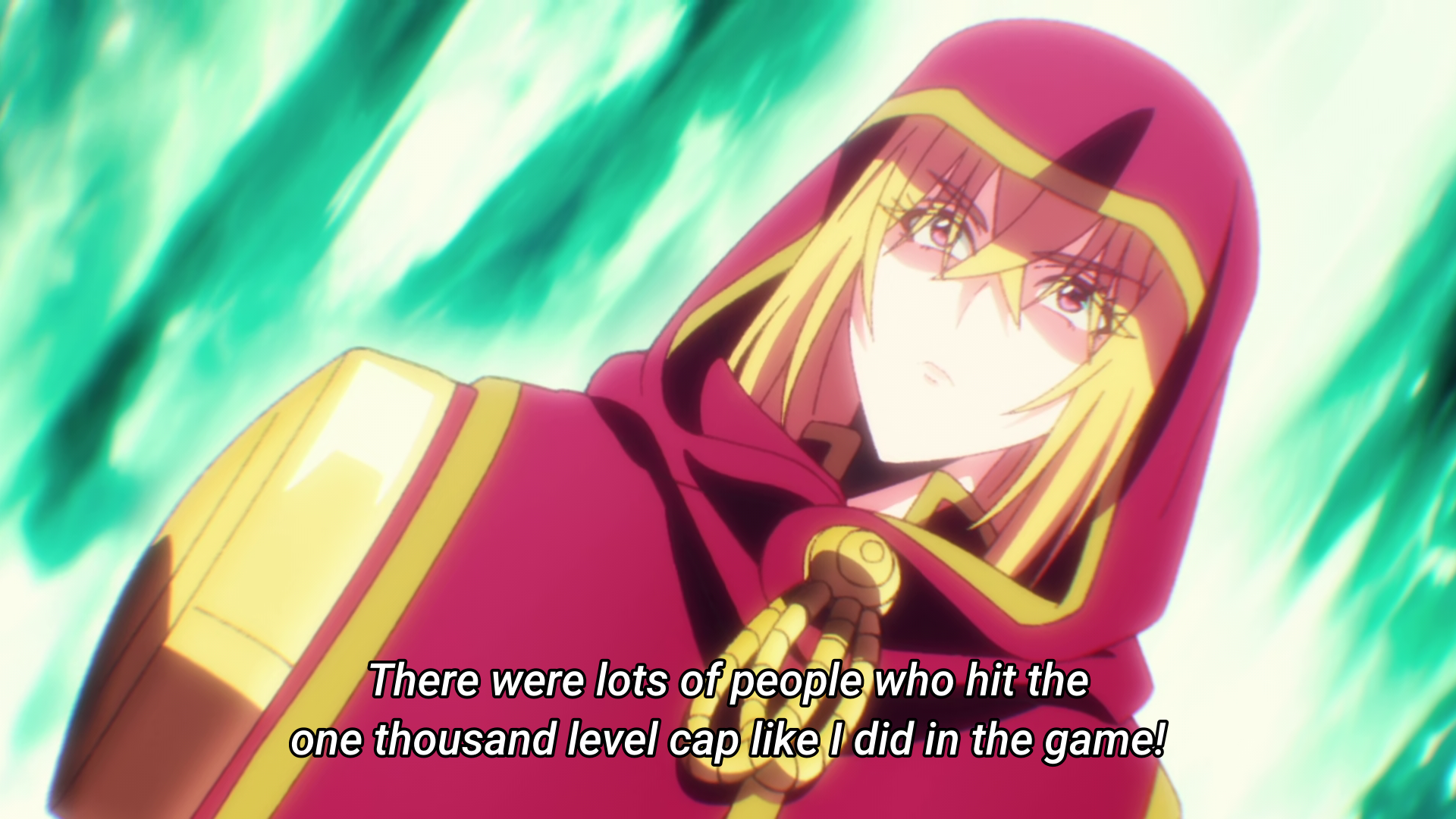
Lufas was very good at a game called Exgate, in which the nominal villain was ignored, because PVP between heroes and building nations was more interesting than the intended plot. And in this game, she (male player) was a legend, the only player to ever conquer the world, before she stepped down and heroes fought among themselves to try and emulate her feat.
Two centuries later, she gets isekaied, and immediately starts (accidentally) terrifying the king who summoned her into submission. She’s thoroughly enjoying herself…
 But gets a bit lonely, and her tower’s in disrepair – at least her NPC maid is still around to orient her and keep her company. She’s terrifying everyone and is a famous historical figure, so she has to go around killing orcs in disguise to earn any money.
But gets a bit lonely, and her tower’s in disrepair – at least her NPC maid is still around to orient her and keep her company. She’s terrifying everyone and is a famous historical figure, so she has to go around killing orcs in disguise to earn any money.
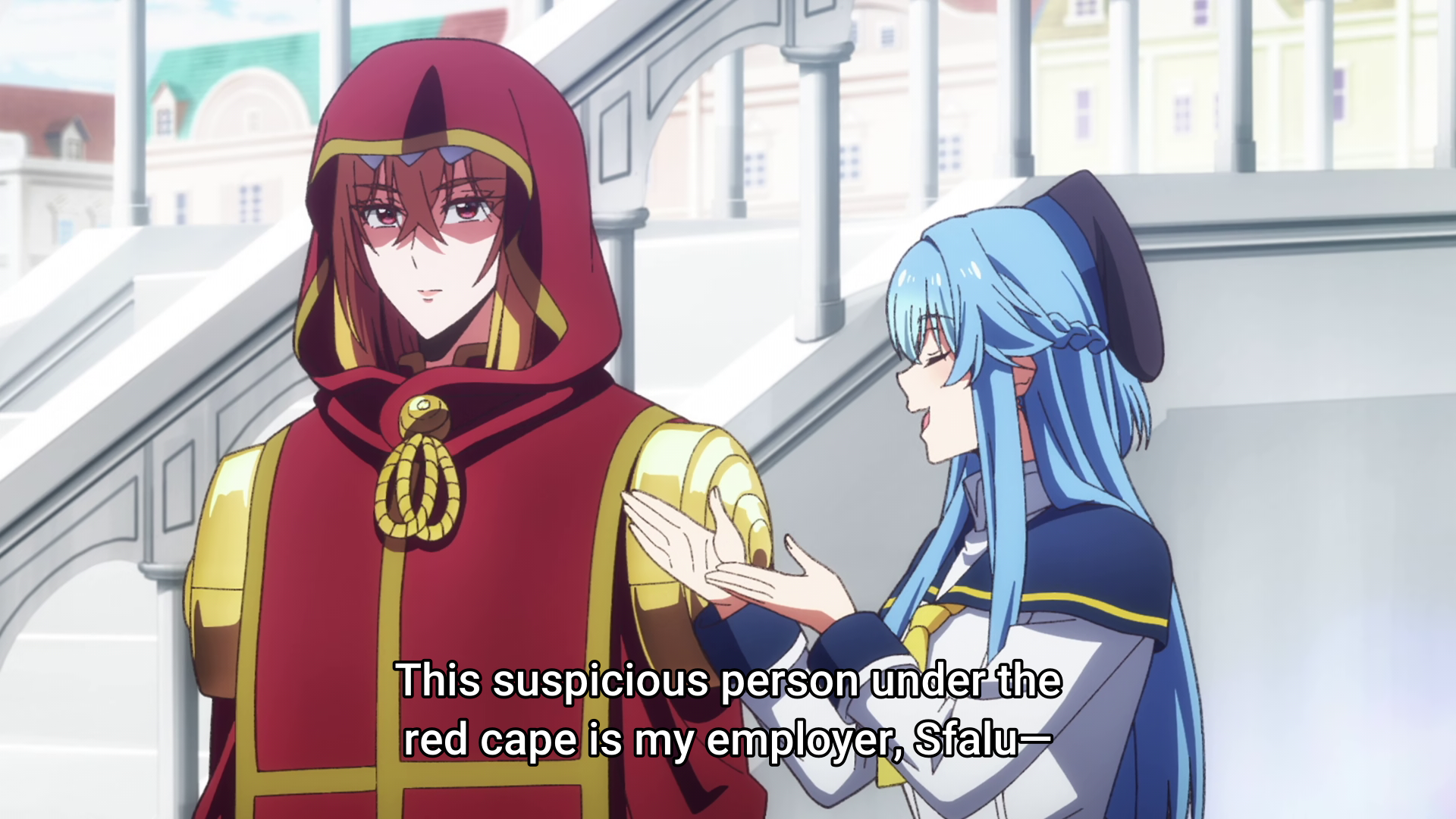 Humanity has been backed into a corner by the devil king, and the library (please support your local library; it has important resources for world travelers) contains books about the past heroes with titles like “humanity’s biggest mistake” – Lufas’ own disappearance has if anything improved her reputation, much like people today often think highly of assassinated politicians who thereby avoided the problems of their successors.
Humanity has been backed into a corner by the devil king, and the library (please support your local library; it has important resources for world travelers) contains books about the past heroes with titles like “humanity’s biggest mistake” – Lufas’ own disappearance has if anything improved her reputation, much like people today often think highly of assassinated politicians who thereby avoided the problems of their successors.
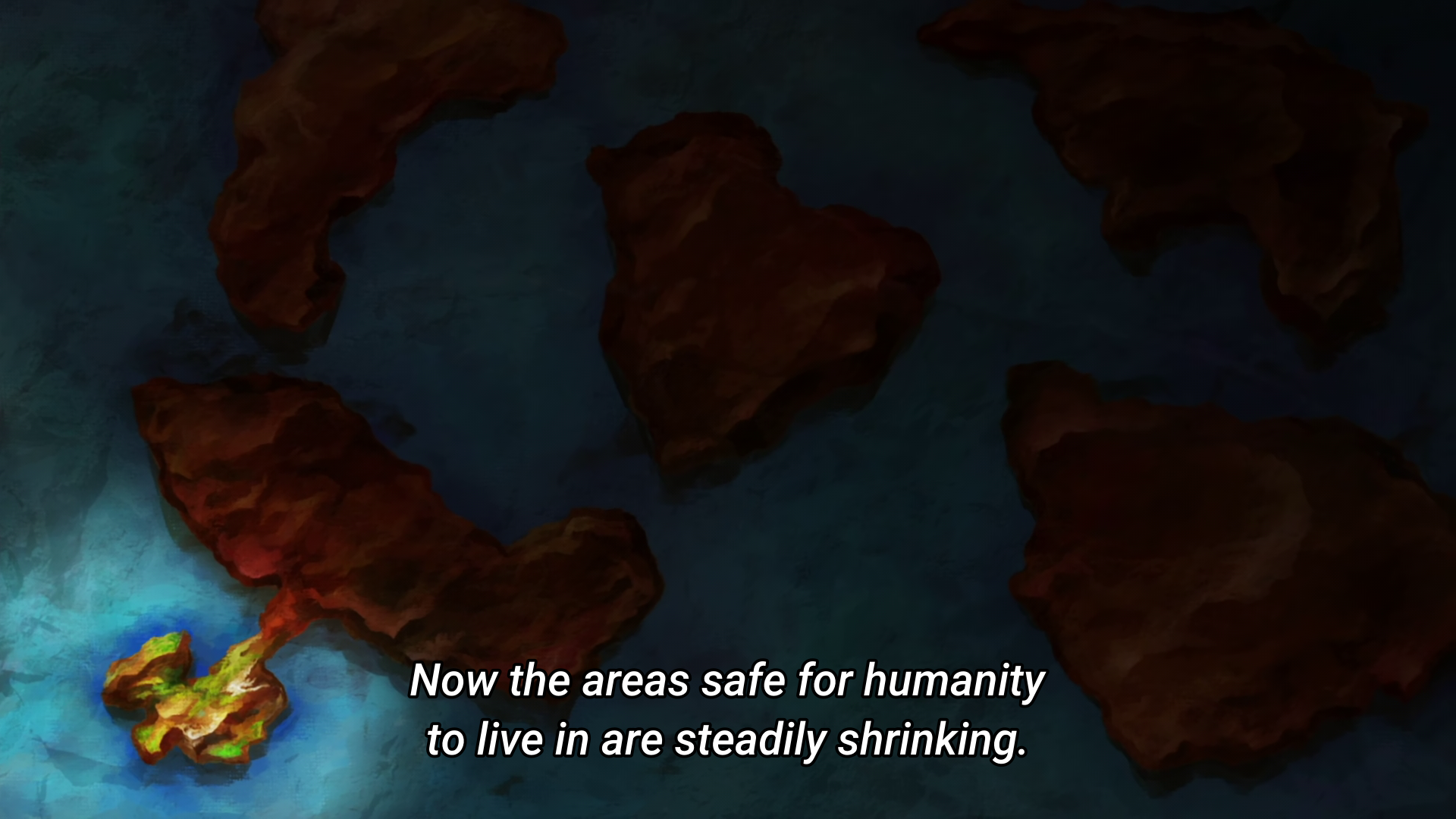
The title originates from the dialogue used when encountering a wild pokemon, and perhaps there’s something to that connection; our main character does reunite with a sheep named Aries – an old friend/animal companion from the game - in episode three, and they’re on a quest for the rest of the Twelve Heavenly Stars (western zodiac) although the first two episodes don’t really look seem particularly strong on any monster taming aspect.
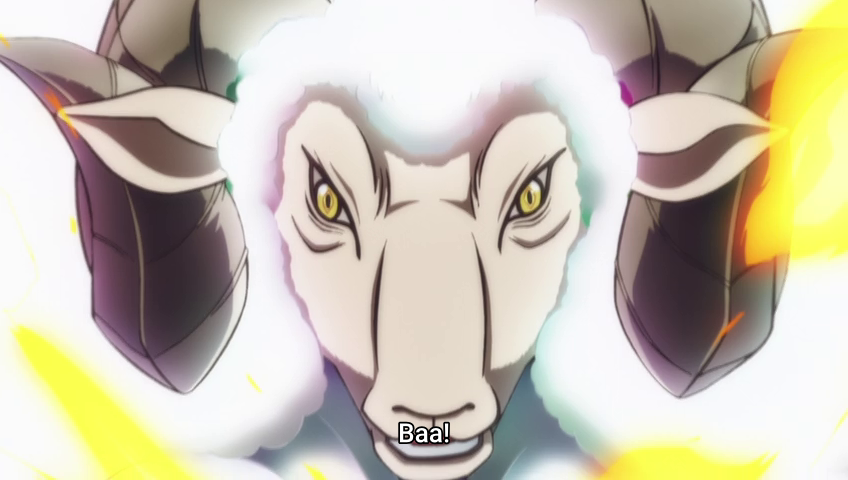 Maybe I’m biased because I like winged girls and fictional histories, but this looks like a lot of fun.
Maybe I’m biased because I like winged girls and fictional histories, but this looks like a lot of fun.
Sozai Saishuka no Isekai Ryokouki is the other title to reach the fabled 3 episode rule at this early point in October, but unfortunately, it has done far less to distinguish itself. It’s the story of a gatherer who gets a bag of holding at the start of his adventure, hunts exotic creatures, and finds items, gets rich, and handles challenges with ease.
The start of Mizuzokusei no Mahoutsukai was like this, and that’s only reaching back to last season; as a fan of the genre, I don’t like to call a title generic, but this one makes it really hard.
The one thing I do remember it for is “the one with the cute dragon”, although even that’s not unique; this season’s also gonna see a small red dragon join another party. He acquires it at the end of episode 1, as a reward for purifying the mana troubling its parent and allowing it to hatch.
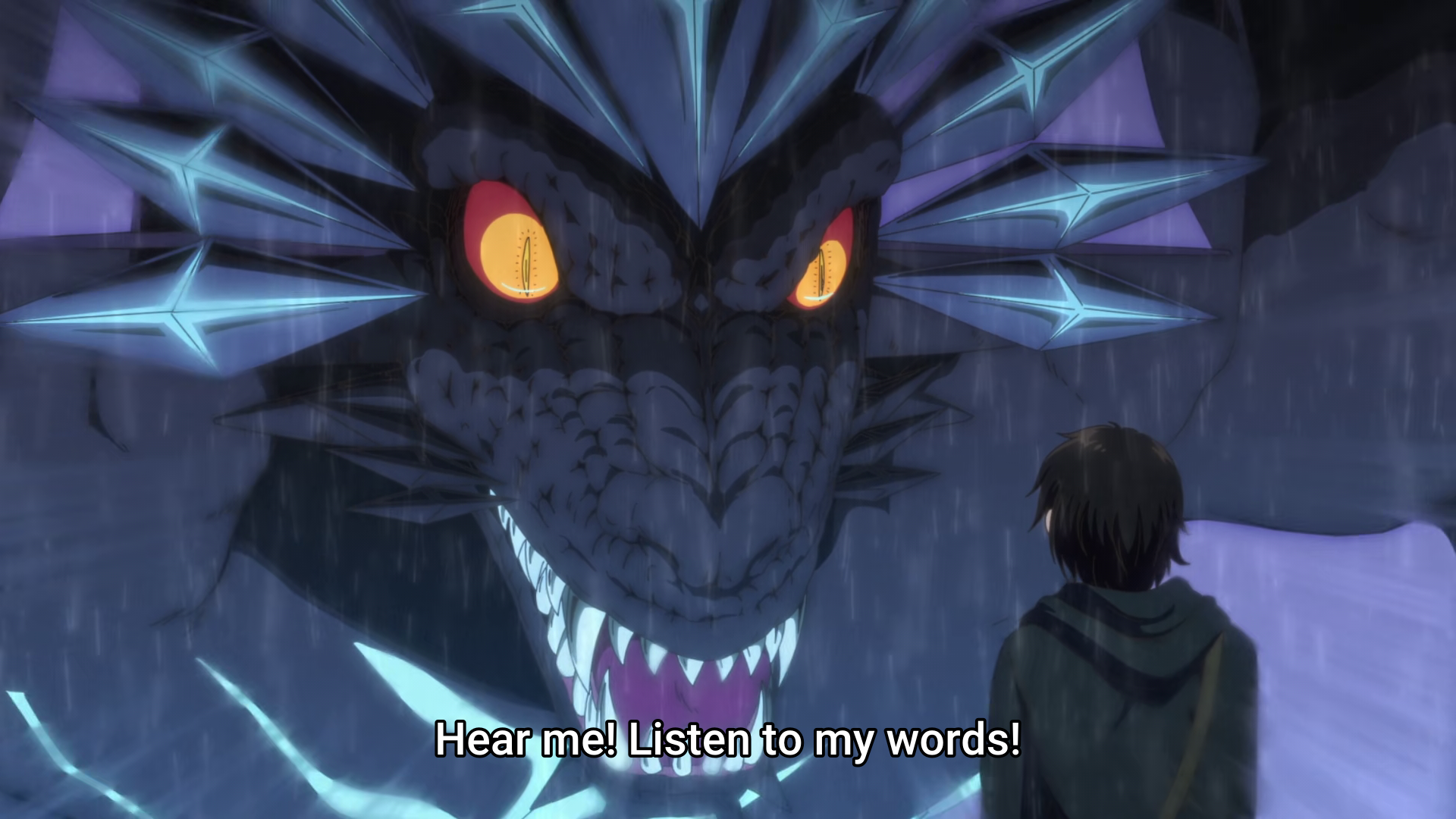
In the 2nd episode, he eats a rock falcon, gets dropped by his baby dragon, gets a branch/staff from Yggdrasil, feeds a starving elf who had struggled in her own adventure, and makes his way to a village, which becomes his new home. He rewards the friends he makes there with a magic lamp that projects a barrier, and then, funded by all the mithril he found, it’s off to the big city and the adventurer’s guild!
Where he has to prove the dragon is really his, so he gives it a tail band that kind of looks like a holy ring.
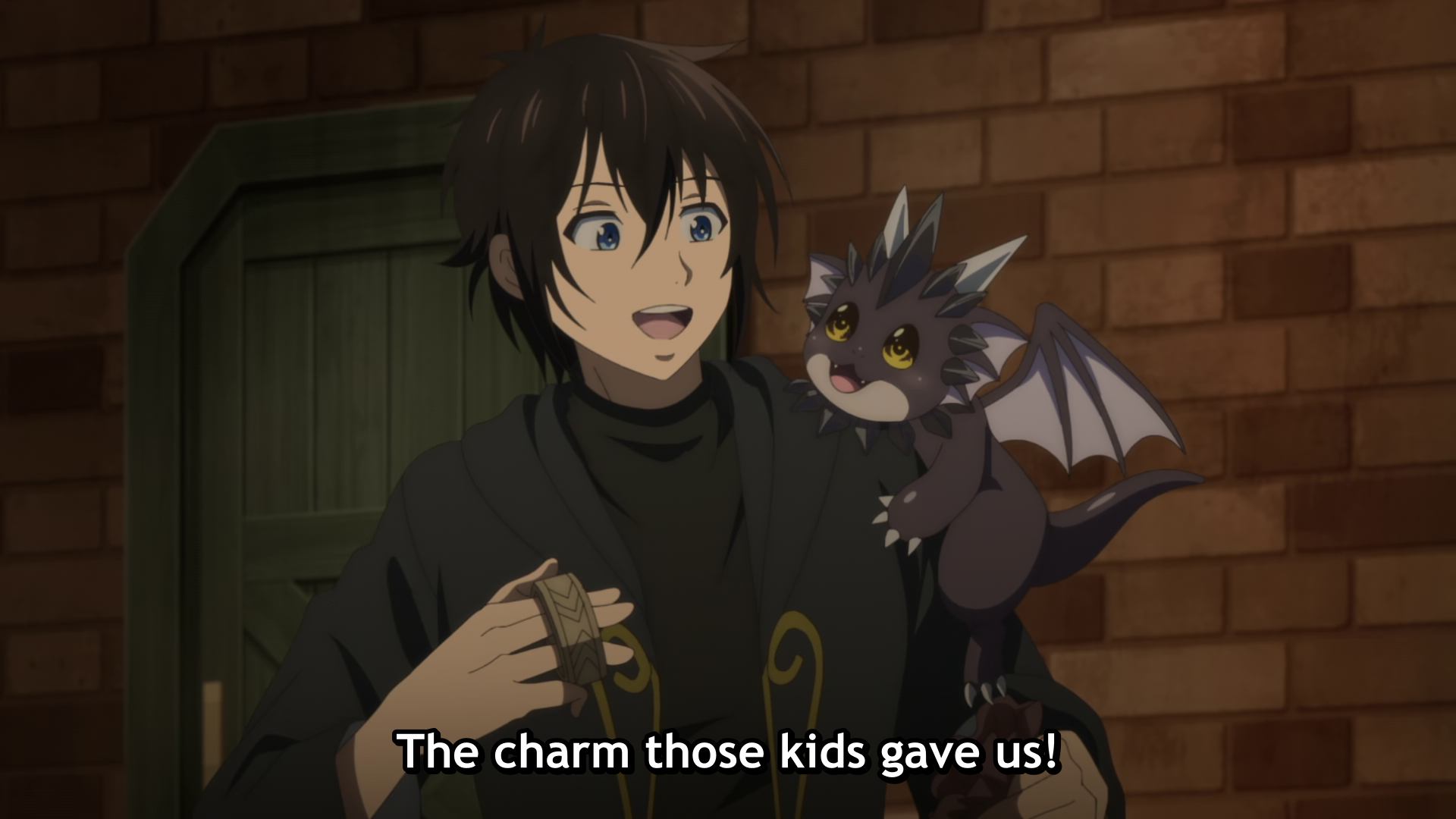 He then shocks everyone with the monsters he eats. Personally, I’m with the rest of the guild; I never cared for the taste of crab. It seems like another case where a hero surprises everyone by simply not knowing his own strength and goes well beyond normal limitations.
He then shocks everyone with the monsters he eats. Personally, I’m with the rest of the guild; I never cared for the taste of crab. It seems like another case where a hero surprises everyone by simply not knowing his own strength and goes well beyond normal limitations.
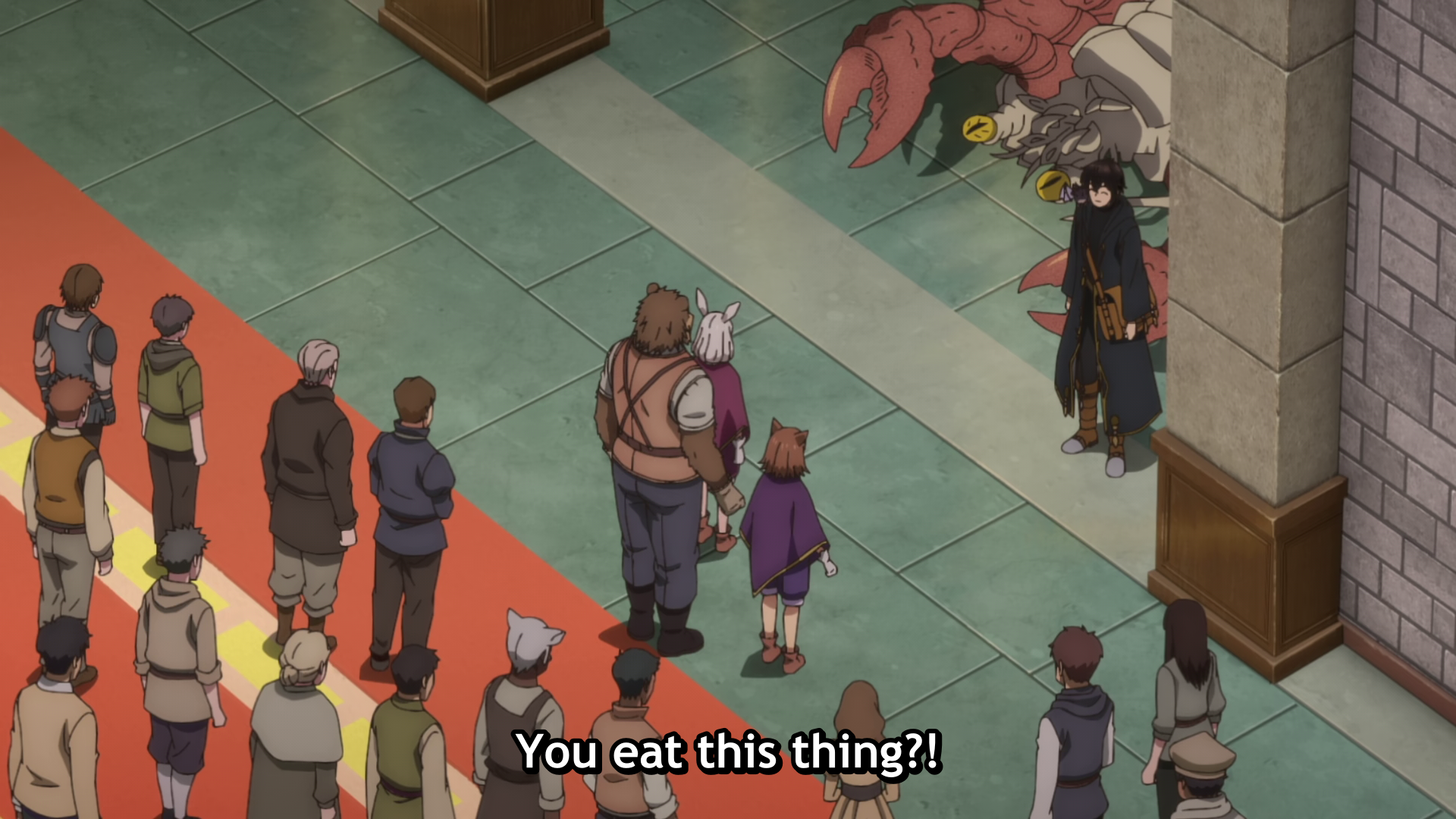 Still, as long as we live in a world full of challenges and setbacks, where monsters are rare and mundane, I can’t say shows like this are a bad time.
Still, as long as we live in a world full of challenges and setbacks, where monsters are rare and mundane, I can’t say shows like this are a bad time.
Tensei Akujo no Kuro Rekishi has a unique and fascinating concept; imagine getting sucked into a world you made up… many years ago, but don’t remember particularly well. Following a pre-existing story is a longstanding trope in villainess stories, and has appeared from time to time in other isekai (most recently, Zenshuu, but being the author herself is certainly a twist! And leads to some interesting metaphysical/metafictional speculation.
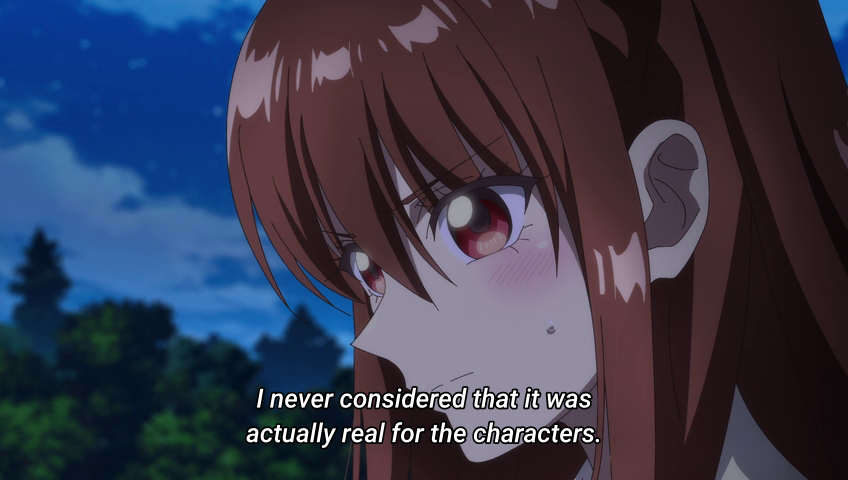
The term Kuro Rekishi, which means dark history, derives from Turn A Gundam, but in otaku slang has developed a meaning of those portions of one’s past that one would rather forget because they’re embarrassing – loosely equivalent to the concept of ‘cringe’. In Turn A, however, the term refers to a suppressed historical record, and perhaps the isekai version of Tenkuro is doing something similar.
Or maybe I'm reaching and it’s just a death by embarrassment grimoire. I’m not certain yet.
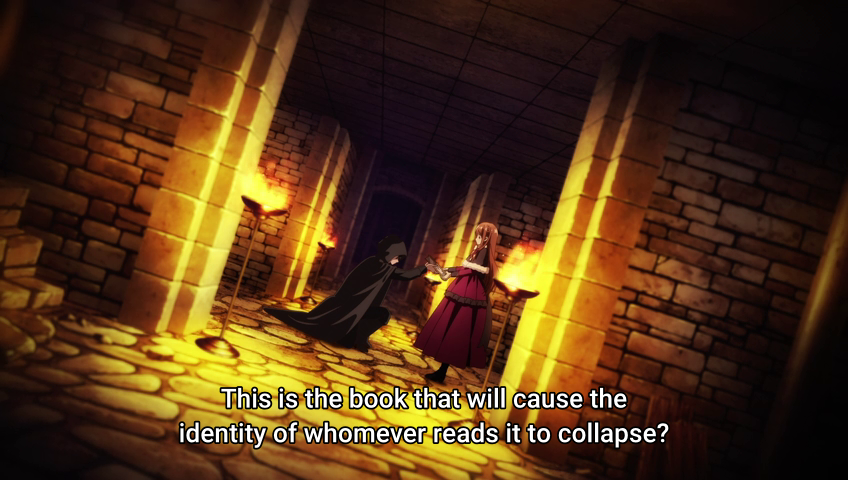
In any case, our main character, Satou Konoha, spent her middle school years writing stories and neglecting schoolwork, while absolutely convinced she’d be sent to another world someday. It didn’t happen… yet. She had to wait until she was in the working world, shocked by her mom throwing away some of her old stuff, when truck-kun finally arrived.
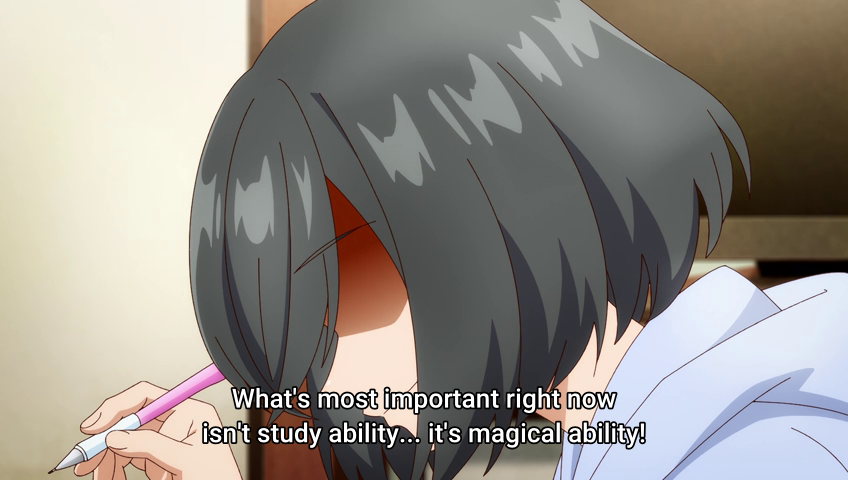
She is reincarnated not as Konoha Magnolia, the beautiful, pink-haired self-insert, but as her younger sister Iana – a classic villainess who dies during the prologue. One wonders if Konoha was taken from the future; in 2015, Hamefura was a recently published light novel, and villainesses were not exactly a popular trope at the time, but maybe she had cutting-edge taste.
Anyway, she’s arrested for Konoha Magnolia’s attempted murder – the sentence is to house arrest in the countryside, but the plan is to have her safely assassinated there, where her sister (who loves her, in spite of everything) can’t see or stop it. Her butler, Sol, who had been rescued from slavery by Konoha and may also be a ninja (they do exist in setting, and he’s remarkably quiet!) makes attempts on Iana’s life, but she’s slowly able to win him over – it does help that she genuinely very much likes her heroine. And then she breaks out and foils an attempt by the next villain, their uncle.
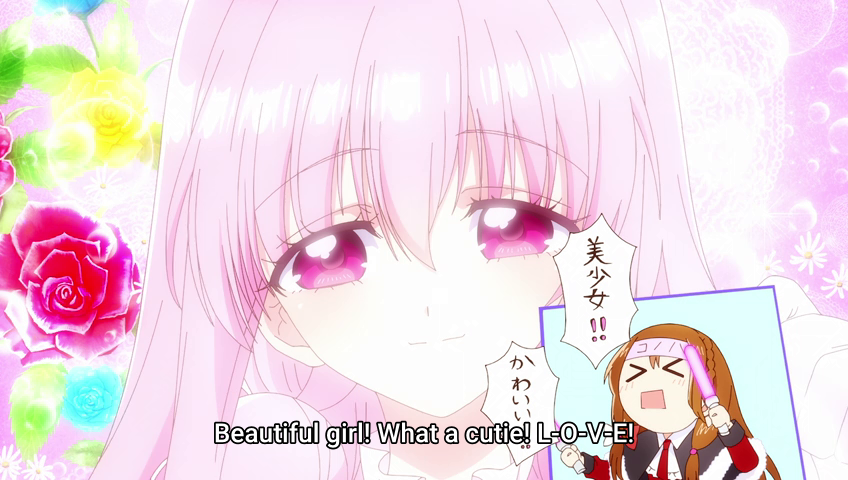 But we still have the rest of the season to go. Will decade-old memories of throwing in everything she liked at the time really hold up – especially when she’s already changing the story? I don’t know, but I’m very intrigued to see what happens to both Konohas next!
But we still have the rest of the season to go. Will decade-old memories of throwing in everything she liked at the time really hold up – especially when she’s already changing the story? I don’t know, but I’m very intrigued to see what happens to both Konohas next!
Ansatsusha de Aru Ore no Status ga Yuusha yori mo Akiraka no Tsuyoi da ga tells the story of a shy kid, Akira, whose presence goes unnoticed back on Earth – but he’s a fan of isekai fond of reading light novels in class, so maybe that means he can handle what’s to come.
 Also pictured is the other title character, our hero, Tsukasa – a class president who gets along with everyone, and a fellow isekai fan.
Also pictured is the other title character, our hero, Tsukasa – a class president who gets along with everyone, and a fellow isekai fan.
And as the title says, the assassin’s stats are way better than anyone else’s, but no one seems to notice. We’ve had at least one assassin hero before, but they’re a prestige class in Dungeons and Dragons and later RPGs have followed its lead; it’s not a default the way thieves/rogues are, let alone fighters or wizards. But unlike Sekai Saikou no Ansatsusha, Isekai Kizoku ni Tensei suru’s Lugh, Akira has never killed anyone before, and is reluctant to do it, even though it’s his class – I guess it’s hard to make assassinating people heroic.
The class is summoned to a world full of political intrigue, with a king overheard planning something sinister (although Akira doesn’t catch exactly what, just that they won’t be a problem – another character mentions sacrifices to summon him) and a knight commander, plotting a coup. Akira befriends said knight, and they exchange stories about one another’s worlds – he offers to assassinate the king for Saran, but Saran, seeking a bloodless coup, refuses him.
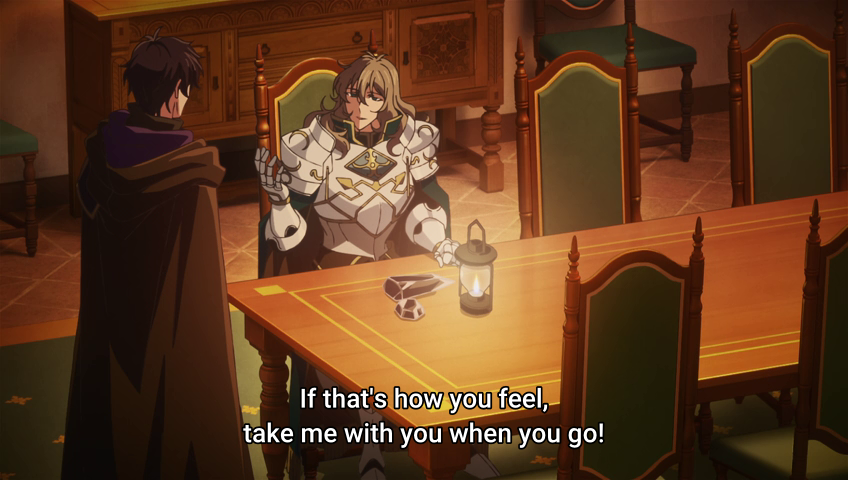 Unfortunately, the king is not so kind, and after some time passing and a dungeon fight with a minotaur, Akira is framed for the murder of what might have been his first real friend in the 2nd episode – fortunately, assassin skills let him escape.
Unfortunately, the king is not so kind, and after some time passing and a dungeon fight with a minotaur, Akira is framed for the murder of what might have been his first real friend in the 2nd episode – fortunately, assassin skills let him escape.
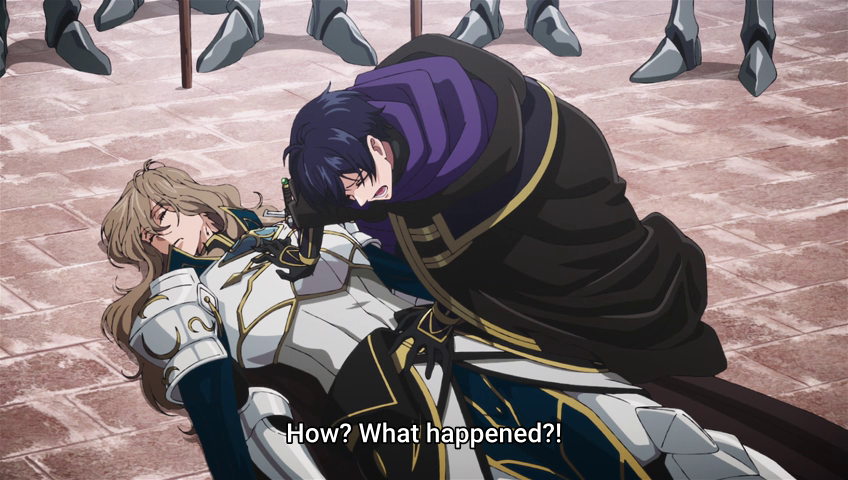 So he’s off in a dungeon, helping an injured elf with a forbidden skill and fighting a dragon when the second episode finishes. There’s some real potential here, even if the formula seems a little close to stuff like Arifureta Shokugyou de Sekai Saikyou or Hazurewaku no "Joutai Ijou Skill" de Saikyou ni Natta Ore ga Subete wo Juurin suru made, and I’m excited to see what happens next.
So he’s off in a dungeon, helping an injured elf with a forbidden skill and fighting a dragon when the second episode finishes. There’s some real potential here, even if the formula seems a little close to stuff like Arifureta Shokugyou de Sekai Saikyou or Hazurewaku no "Joutai Ijou Skill" de Saikyou ni Natta Ore ga Subete wo Juurin suru made, and I’m excited to see what happens next.
Chichi wa Eiyuu, Haha wa Seirei, Musume no Watashi wa Tenseisha, at least as of its first two episodes, focuses far more on the hero father than it does the reincarnated daughter, even if the title (and the source material’s text, although an anime adaptation loses the first/third person distinction by its nature) suggests the story is from the latter’s point of view.
The story opens with a fairy tale like telling of the romance between the hero, Rovel, and the fairy queen, Origin, and his disappearance into the fairy realm.
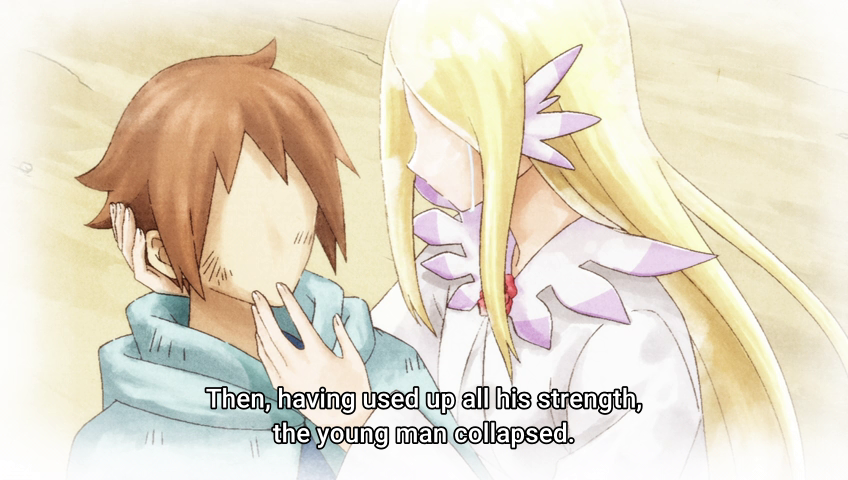 The isekai tensei character of the story, Ellen, was a materials scientist in her past life, and does get one moment to shine, compressing carbon to make diamond rings for her parents at their wedding.
The isekai tensei character of the story, Ellen, was a materials scientist in her past life, and does get one moment to shine, compressing carbon to make diamond rings for her parents at their wedding.
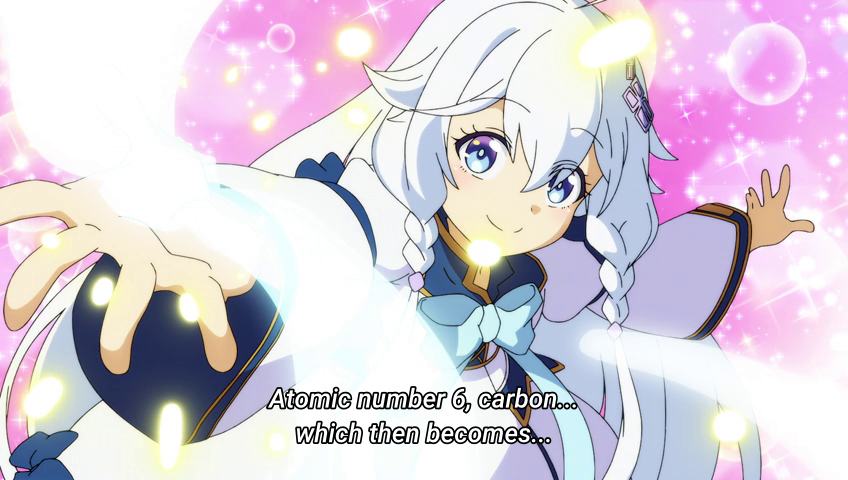 I think a magic system based around the periodic table and chemistry, making use of her past life knowledge, could be interesting, but she hasn’t had the chance to actually *do* all that much yet; the 2nd episode is mostly spent scrying with her mother, while her father saves her uncle from an arranged marriage to a tyrannical princess. The princess in question, Agiel, is that rare example in contemporary isekai of a villainess who isn’t an otherworlder trying to avoid her inevitable fate; she’s cruel, spoiled, a bully, responsible for the death of the hero’s father, wastes public money on extravagances.
I think a magic system based around the periodic table and chemistry, making use of her past life knowledge, could be interesting, but she hasn’t had the chance to actually *do* all that much yet; the 2nd episode is mostly spent scrying with her mother, while her father saves her uncle from an arranged marriage to a tyrannical princess. The princess in question, Agiel, is that rare example in contemporary isekai of a villainess who isn’t an otherworlder trying to avoid her inevitable fate; she’s cruel, spoiled, a bully, responsible for the death of the hero’s father, wastes public money on extravagances.
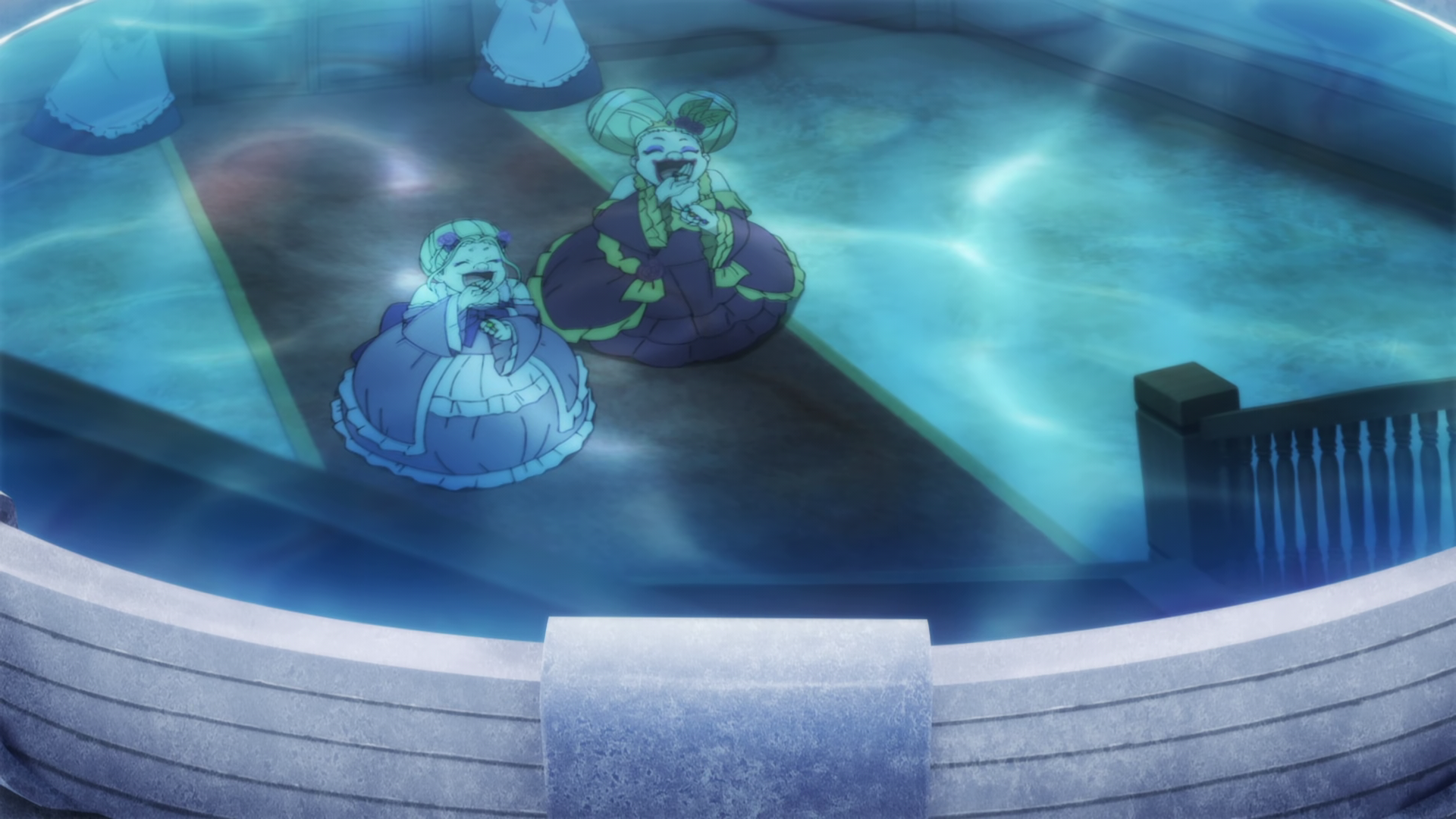 As Agiel was decisively defeated in the 2nd episode, with the divorce accepted and she got sentenced to a magic barrier which prevents her from even approaching men, I do wonder where they’ll go from here. There is something about the crown prince which does seem a little sinister. Whatever happens, I hope Ellen gets something to do and it won’t just be her dad’s story.
As Agiel was decisively defeated in the 2nd episode, with the divorce accepted and she got sentenced to a magic barrier which prevents her from even approaching men, I do wonder where they’ll go from here. There is something about the crown prince which does seem a little sinister. Whatever happens, I hope Ellen gets something to do and it won’t just be her dad’s story.
Potion Wagami wo Tasukeru is the story, told in half-length episodes, of a confused girl who learns a simple potion spell to survive and support herself. It is easy, at first, to confuse it with Potion-danomi de Ikinobimasu!, with their similar titles and somewhat similar looking heroines, whose names both start with ‘Ka’, and both heroines are indeed potion makers.

Poukin’s heroine, however, had a goddess to introduce her to the other world, a wide variety of potions, and acquires wealth and power (and gets involved in high politics) from a fairly early part of her title; Potion Wagami wo Tasukeru’s Kaede, who suddenly wakes up in another world, has no such luck. At first, she thinks she’s in another country, perhaps in Europe, until she meets a lizardman on the street chatting with a girl as if everything is normal.
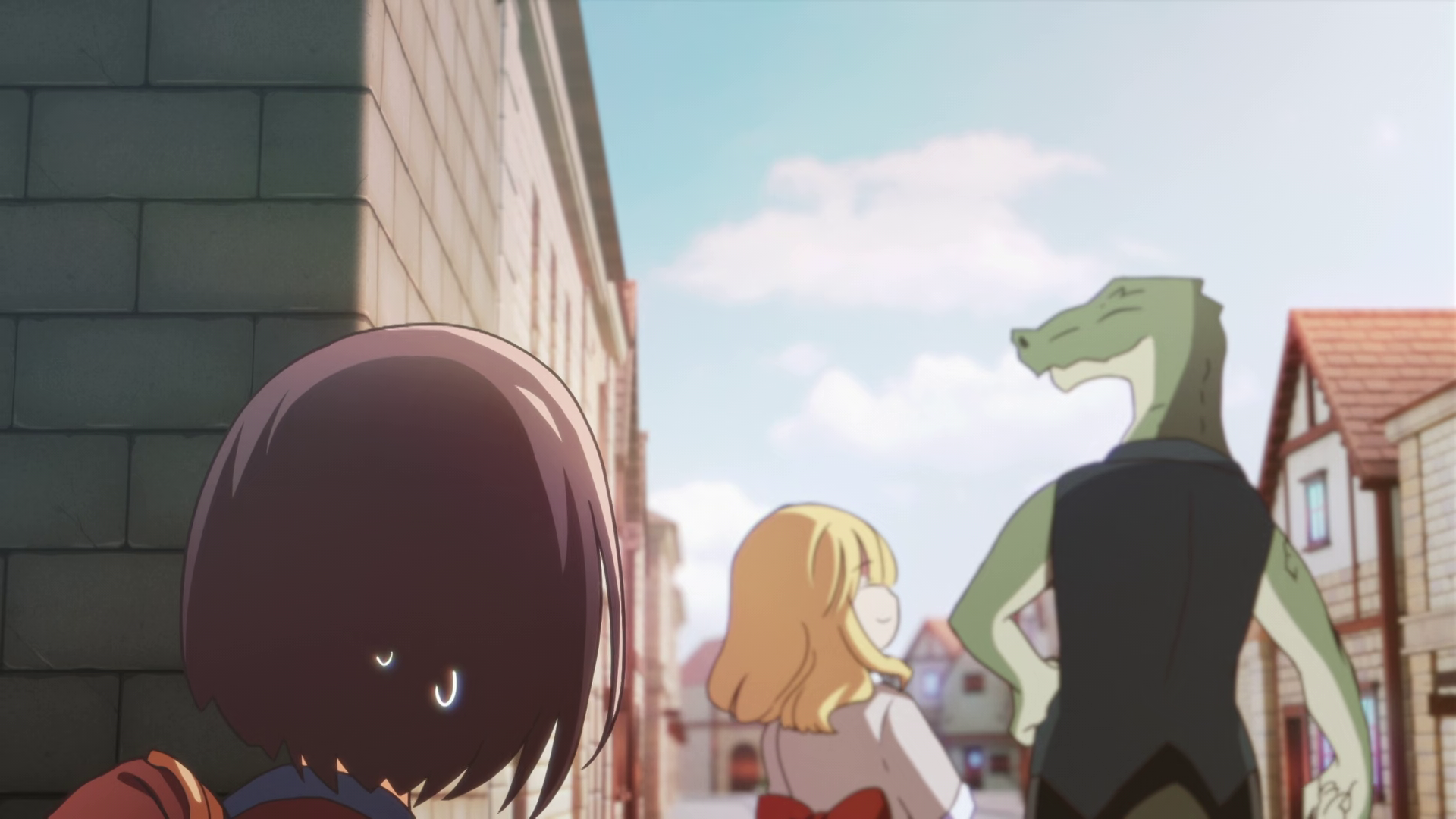 She finds a recipe book (spellbook) in her backpack with a message from whoever summoned her. Using her cellphone as a flashlight, she gathers grass and water and makes her first potions.
She finds a recipe book (spellbook) in her backpack with a message from whoever summoned her. Using her cellphone as a flashlight, she gathers grass and water and makes her first potions.
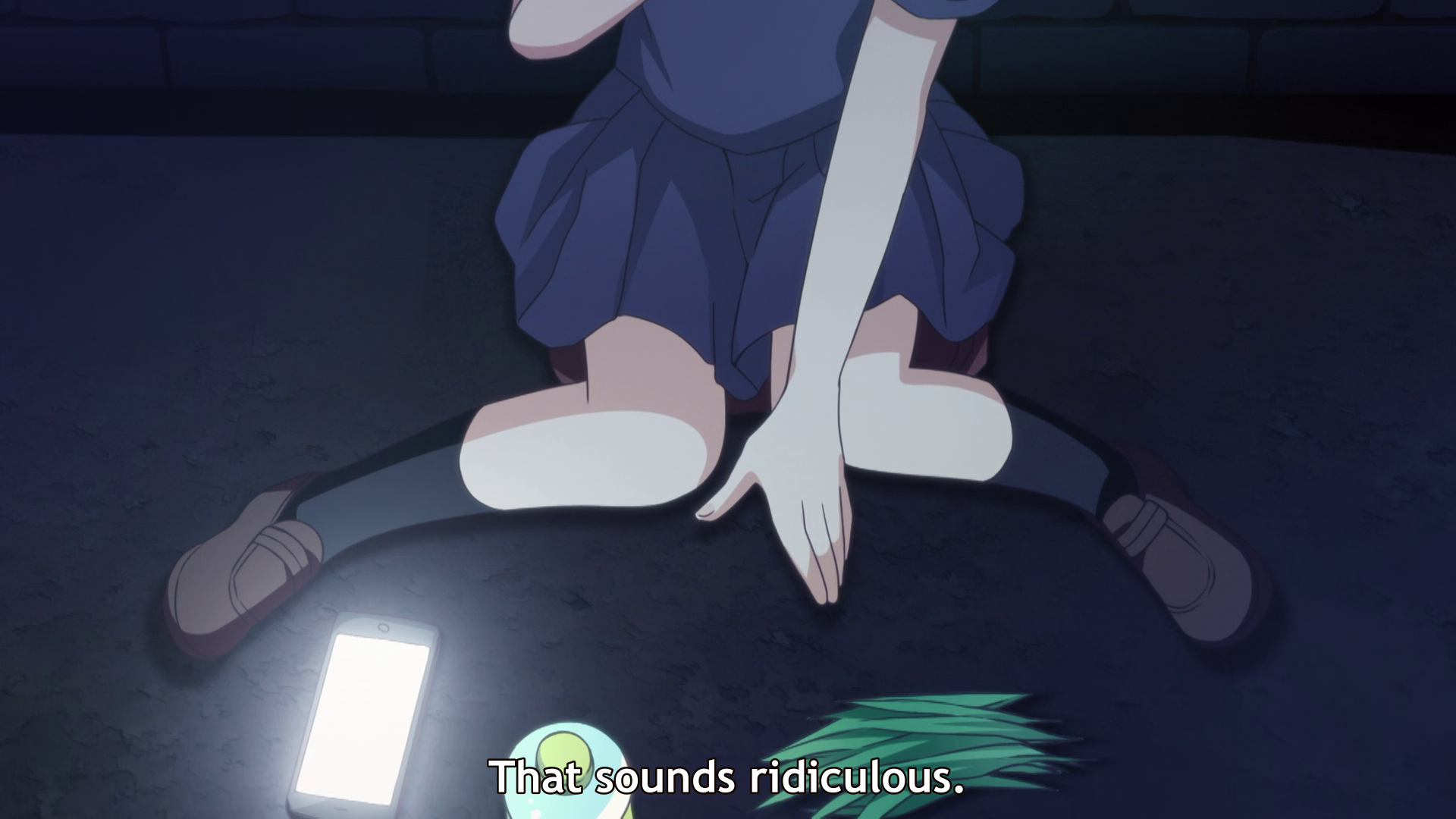 She finds somewhere to sell them, while asking a bunch of basic questions about the town (with the ridiculous name of Rickifornia) and the world she’s now in. She might be lucky, in that situation, not to get ripped off; or maybe we’ll find out later she was actually underpaid but it didn’t matter because the ingredients are so easy to gather. Still, she finds an inn (which writes her normal Japanese name in katakana; she’s undeniably foreign here) and in the 2nd episode makes her way to the guild library and buys a cat-shaped magic bag/purse of holding.
She finds somewhere to sell them, while asking a bunch of basic questions about the town (with the ridiculous name of Rickifornia) and the world she’s now in. She might be lucky, in that situation, not to get ripped off; or maybe we’ll find out later she was actually underpaid but it didn’t matter because the ingredients are so easy to gather. Still, she finds an inn (which writes her normal Japanese name in katakana; she’s undeniably foreign here) and in the 2nd episode makes her way to the guild library and buys a cat-shaped magic bag/purse of holding.
She still doesn’t know what she’s doing, she still wants to go home. But if all else fails, at least she’s cute and has a nice spell.

Tondemo Skill de Isekai Hourou Meshi will never be a favorite of mine, but it has won itself a sizable fanbase. My local bookstore always has plenty of copies of the manga, and it’s always nice whenever an isekai series does well enough for a 2nd season. Tondemo Skill has done well enough to spawn imitators (one can certainly see its inspiration behind this year’s Around 40 Otoko no Isekai Tsuuhan, which also makes heavy use of online alternate-world delivery) and while the food doesn’t personally appeal to me, I can still appreciate the otherworldly adventures of a man, his dog, his slime – and a dragon joining them at the start of this season, which, in line with the naming sense that sees his slime named ‘Sui’, he calls Dora-chan, to its protests.
There’s a webbing gathering quests, there’s leftovers to share at the adventurer’s guild, there’s a new quest to get rid of an Earth Dragon’s hide… but we all know what you’re really here for.
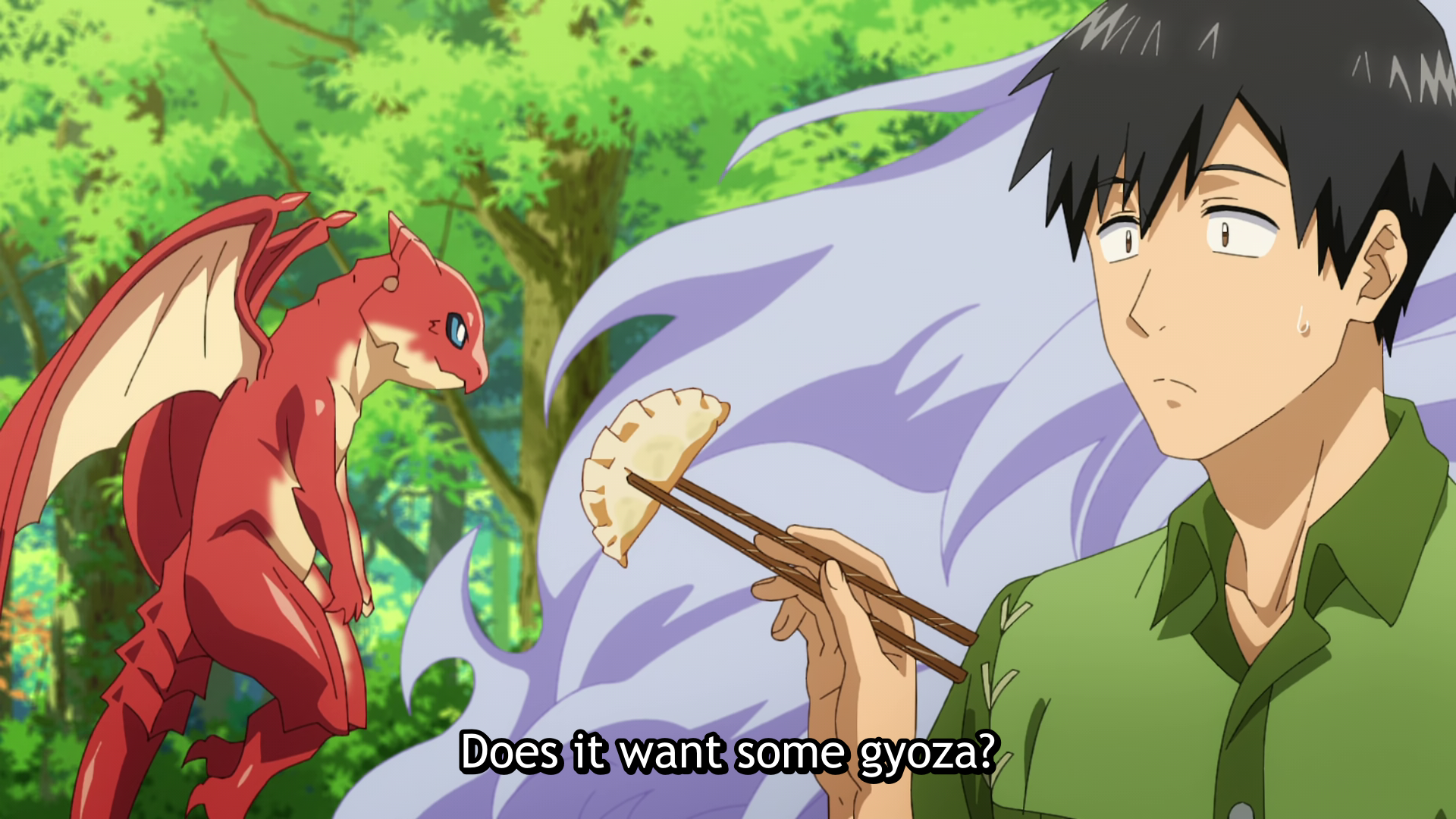
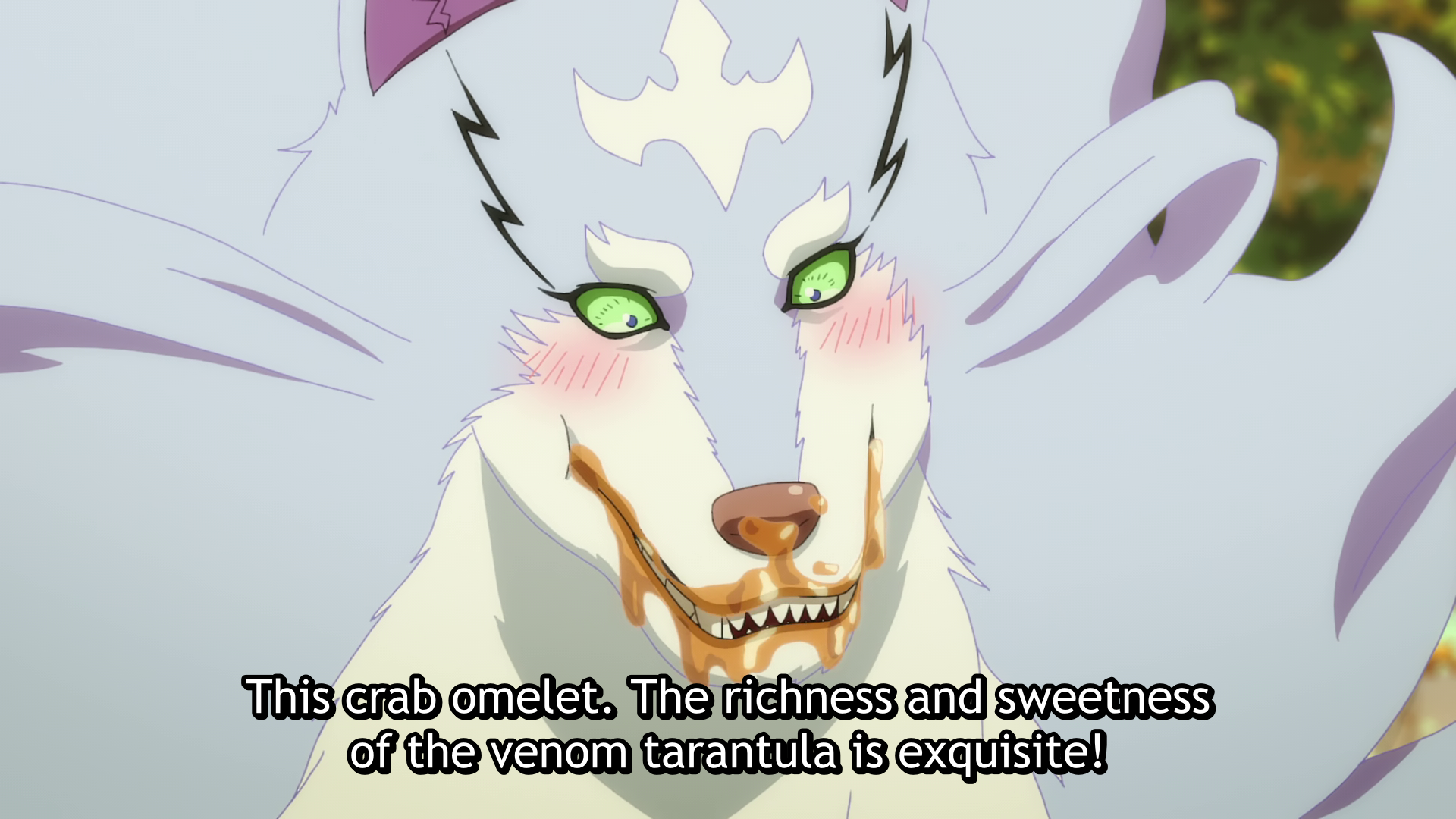
Kekkon Yubiwa Monogatari returns for a second season as well this fall, and more than lives up to its namesake in its 2nd episode. Yubiwa Monogatari is the Japanese title of The Lord of the Rings. (The official English title, “Tales of Wedding Rings, matches its literal meaning but unfortunately obscures this connection). After a first episode focused mainly on reintroducing the characters and plot, we get a historical flashback, an ancient betrayal (this time, by the hero’s wives – plural – only one of whom shed a tear for him) and a fear that the ringbearer will abuse his power to become a tyrant like his predecessor; this title resembles its namesake in more than just its fantasy setting.
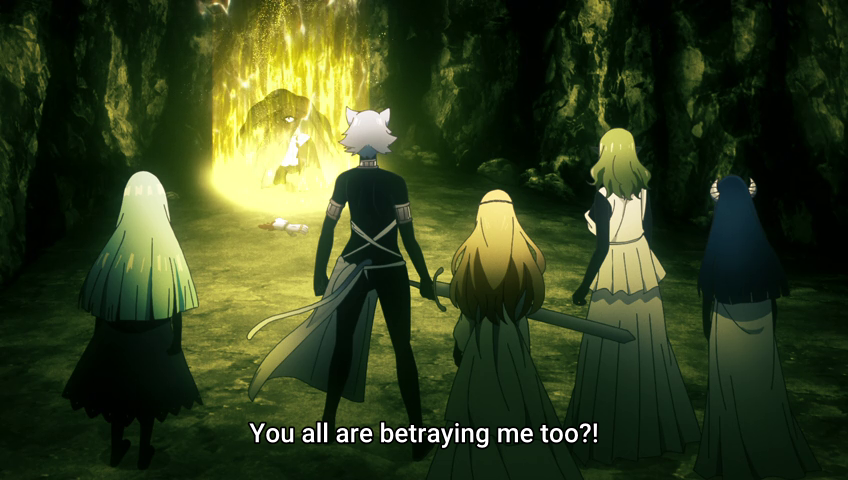
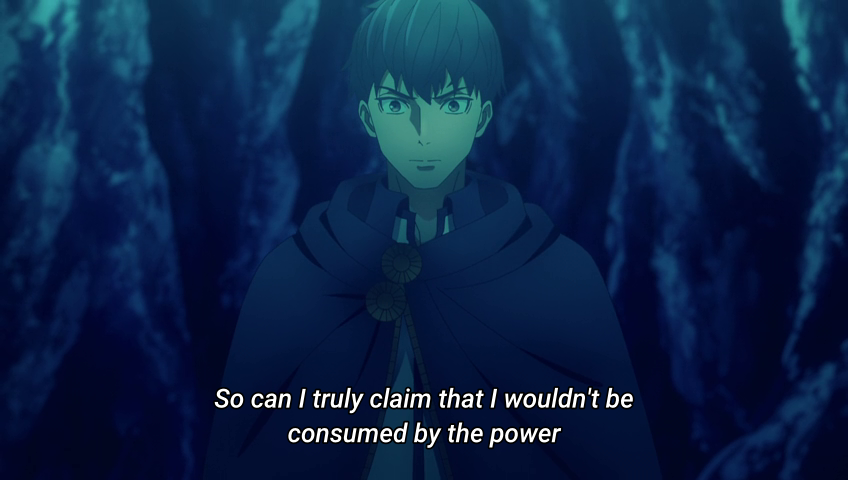
The show remains very much an ecchi harem, complete with nipples in the opening theme, but that aspect is a lot more fun when it comes packaged with an adventure story. It’s a formula which has worked well before – I very much enjoyed Cross Ange, and for a more straightforwardly isekai example there’s El-Hazard - and legal royal polygamy at least tones down the fighting and “who will win” tension that got so frustrating in older harem titles, although even this-world harem anime appear to be moving away from that these days.
There’s still more than a little “just fuck already” tension, but at least it comes in the context of developing romances and girls who genuinely like the lead.
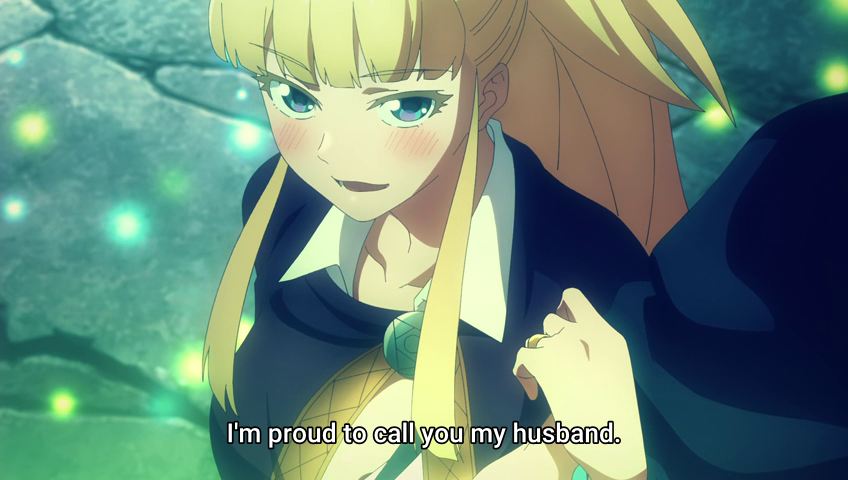 Trapped in an elven library, in need of more power to escape and defeat the Abyss King, maybe Satou and his girlfriends will finally do so… next week. Or maybe they’ll get cockblocked again, I haven’t read the manga, but it wouldn’t be the first time.
Trapped in an elven library, in need of more power to escape and defeat the Abyss King, maybe Satou and his girlfriends will finally do so… next week. Or maybe they’ll get cockblocked again, I haven’t read the manga, but it wouldn’t be the first time.
Isekai Quartet’s name has become increasingly antiquated, but it returns for a third season, with Shinchou Yuusha’s Seiya and Ristarte representing the seventh series to join the club. With only one cour worth of anime and no movie, this was not a title I would’ve expected – I guess it’s like when Majestic Prince gets into Super Robot Wars or some of the more surprising Super Smash Brothers inclusions. Crossovers are rare in anime and the medium does not lend itself well to massive numbers of series interacting - there’s a reason SRW, despite using entirely anime and manga source material, is a game series - but when done well it can create a sort of canon of notable titles and get people into things they hadn’t heard of before.
Then again, Isekai Quartet isn’t an epic adventure, but a gag anime set in a high school...
I do want to see Aqua interact with Ristarte, but we’re yet to reach any damegami interaction, or even have the Shinchou Yuusha characters meet the rest of the cast. Instead, we get a sumo contest (with the otherworlders roped in as referees) whose final, between Overlord’s Albedo and Re:Zero’s Garfiel, turns into something out of Dragon Ball, along with plenty of theorizing about what’s going on and how to get home.
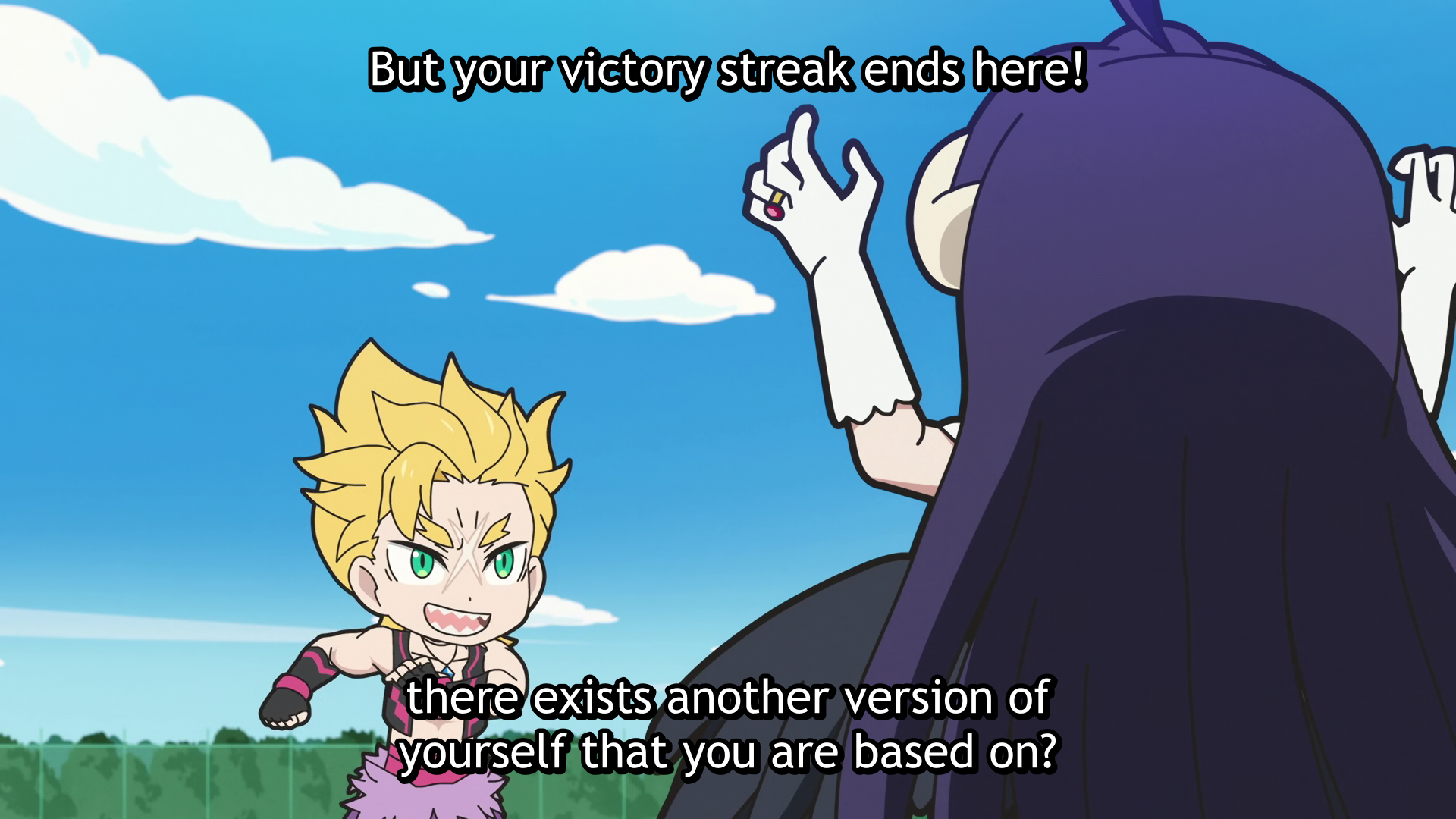
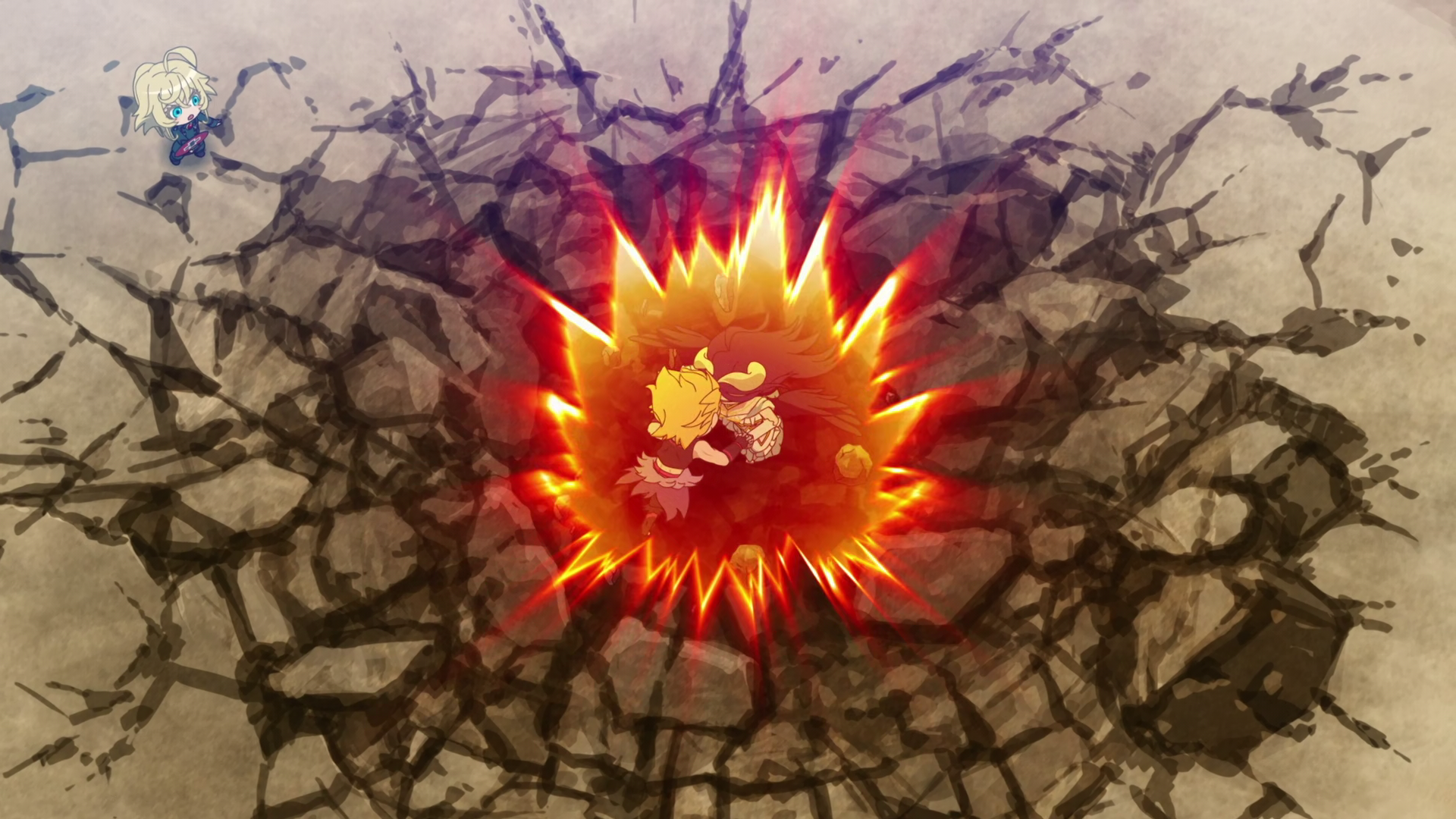 There’s something special about this show, and some of the jokes are legitimately funny… but Konosuba is funnier and I think its choice of format squanders much of its potential.
There’s something special about this show, and some of the jokes are legitimately funny… but Konosuba is funnier and I think its choice of format squanders much of its potential.
Finally, Digimon Beatbreak, as of its first two episodes, is unfortunately not an isekai; its futuristic setting shows digimon born from AI-like eggs called Sapotama, with no mention made yet of any digital world. Every Digimon TV anime to date, however, (and the vast majority of its games) has contained isekai elements - Digimon Savers, which shares staff, an older cast, and a government coercing people with partner digimon to solve digimon incidents with Beatbreak, had them travel there midway through. So I am hesitant to reject the possibility, and will be keeping an eye on the show.
Plus I’m a lifelong fan of the franchise and Digimon Adventure was my entry gate to isekai, so of course I’ve gotta watch a new digimon anime! I've been playing Digimon Story: Time Stranger as well, which is the first digimon game to send you frequently back and forth between worlds; it has a wonderful story, and look for a post on it soon, once I collect my thoughts and finish the sidequests.
And of course, enjoy the new season!